European Badger Profile
In The Animals of Farthing Wood, European mammals, reptiles, amphibians and birds, worked together to escape human destruction of their habitat and find a new home.
The kestrel was the lookout, the mole was the architect, the fox was the charismatic leader, and Badger was the wise and dignified second-in-command and peacemaker; a tribute to the intelligence and social responsibility of the non-fictional creature, the European (or Eurasian) Badger.
The European badger is a species of badger in the Mustelidae family, which includes weasels, otters, and wolverines. They live in stable populations across Europe, West and Central Asia.
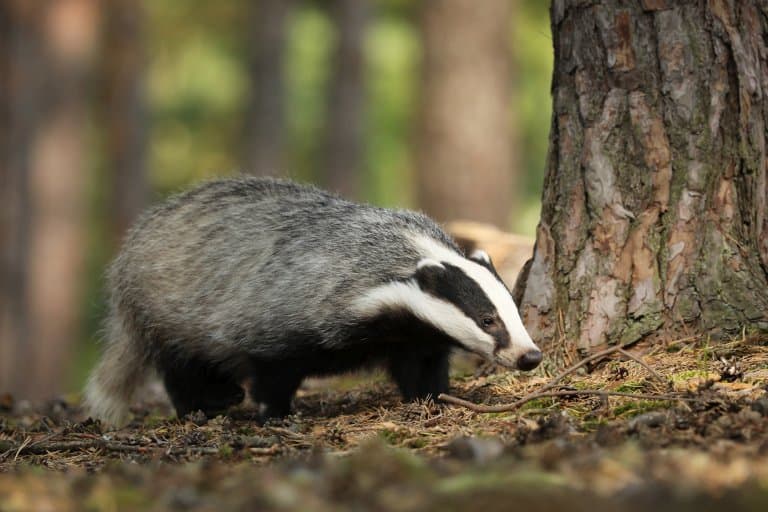
European Badger Facts Overview
| Habitat: | Wooded areas, underground |
| Location: | Widespread across Europe |
| Lifespan: | 15 years in the wild |
| Size: | 30cm (1ft) tall, 1.2m (4ft) long. |
| Weight: | Up to 17kg 37lb) |
| Colour: | Black and white |
| Diet: | Cereals, berries, insects, snails, frogs, mice, rabbits |
| Predators: | Humans, dogs, wolves, lynxes, golden eagles |
| Top Speed: | Slow |
| No. of Species: | 1 |
| Conservation Status: | Least Concern (IUCN) |
The European badger is nocturnal and lives in woodlands and shrublands across Europe and Asia.
It’s incredibly powerfully-built and stereotypically black, white and grey in appearance. They grow up to around 90cm in length, and can weigh up to 17kg.
It’s impossible to overstate how lovely badgers are. They happily snuffle and grunt as they nose about the garden eating slugs and earthworms, and minding their own business.
They’re also incredibly friendly and playful with people when habituated, and show intelligence that’s on par with more acceptable companions like dogs and cats.
So, it’s an ongoing disgrace that they are continually persecuted under false or violent pretences by farmers, hunters and perpetrators of blood sports across the continent.
But despite this, they’re one of the most successful wild animals remaining.
Interesting European Badger Facts
1. Their name might derive from the word ‘badge’
The origin of the term “badger” is uncertain.
The word ‘badger’ is thought to stem from ‘badge’ + -ard, in allusion to the white spot on the badgers forehead that resembles a badge.
This is thought to be from the early 16th century.
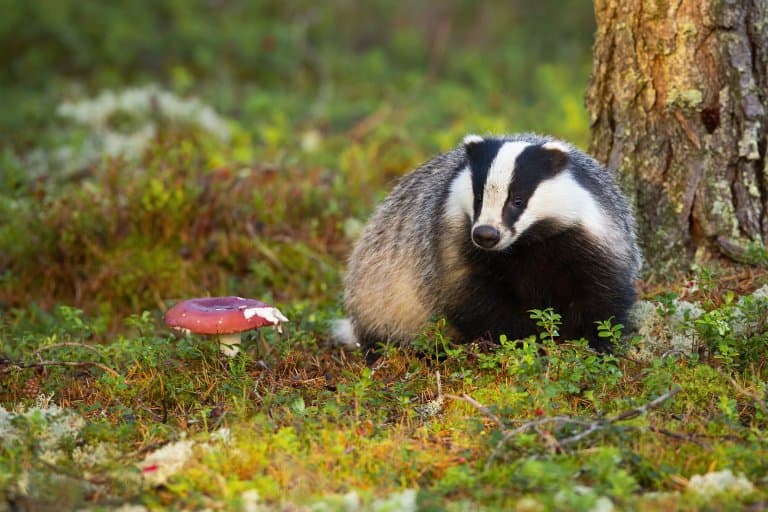
2. They’re mustelids
Despite looking like nothing else around, badgers are part of a wide family of intelligent, hardworking animals. The mustelids include weasels, stoats, wolverines and otters.
These are in the Carnivora order and are all known for being powerful mesopredators with a tenacity and resilience that’s hard to match.
Badgers are no different. As one of the largest mustelids, these are powerfully built animals with heavy skulls and strong, clawing limbs. Their thick fur is loose and dense, and when cornered, they can defend themselves very honourably.
Though, badgers are not aggressive by nature, quite the opposite. 1
3. They can bark, scream, cluck, and even purr
While the vast majority of mustelids are solitary, badgers live in large groups and are remarkably social. Families of around six badgers typically occupy a single subterranean tunnel system called a sett.
Though these families can get significantly bigger, into the twenties. They have significant territories, sometimes reaching upwards of 350 acres. Throughout most of the year, these badgers live and play together without incident, though males will engage in fierce fights during mating season.
Group adhesion is achieved in part using a wide vocal repertoire; badgers can bark, twitter, scream, growl, grumble, coo, cluck and purr among others. 2
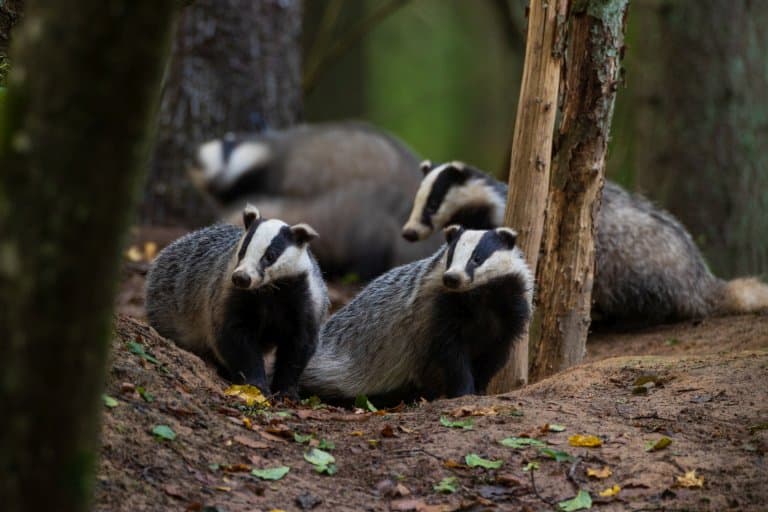
4. They can dig tunnels up to 80m in length
One of the key traits in badgers that brings them into conflict with humans is their choice of home. When digging their sets, badgers can unearth a significant amount of field, garden, or lawn.
The setts made by European badgers are permanent structures, used for generations. Sometimes, they overlap, becoming communal abodes for more than one family, and these can be vast.
Setts contain emergency exits, nesting chambers, and several sleeping chambers which will be regularly filled with fresh bedding from outside. 3
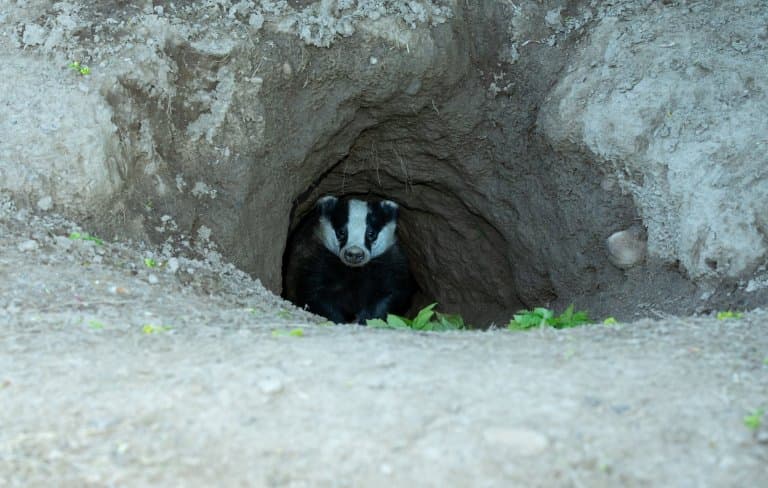
5. They have their own toilets
Their setts are well maintained to reduce parasitic accumulation.
Badgers don’t poop where they sleep, they are far too smart for that. They are extremely fussy over the cleanliness of their burrows and will often replenish bedding with fresh straw, grass and leaves.
When they need the loo, they defecate in ‘latrines’ – which are essentially shared animal toilets. These are situated outside their setts, or en route to other setts for ease.
If a badger dies in a sett, other badgers in their group will seal off the chamber and dig a new one – or pull them outside, and bury them.
6. They sleep over winter
Badgers start to accumulate fat reserves in late summer to prepare for their winter sleep, which begins typically in late October when snow falls.
In the Nordics and Russia where the climate is very cold badgers will sleep from October/November, right the way through to March/April when spring arrives.
They do this by fattening themselves up and blocking themselves in their sett using leaves and dirt.
In warmer European countries where the winter isn’t nearly as harsh, badgers can decide not to sleep over winter at all.
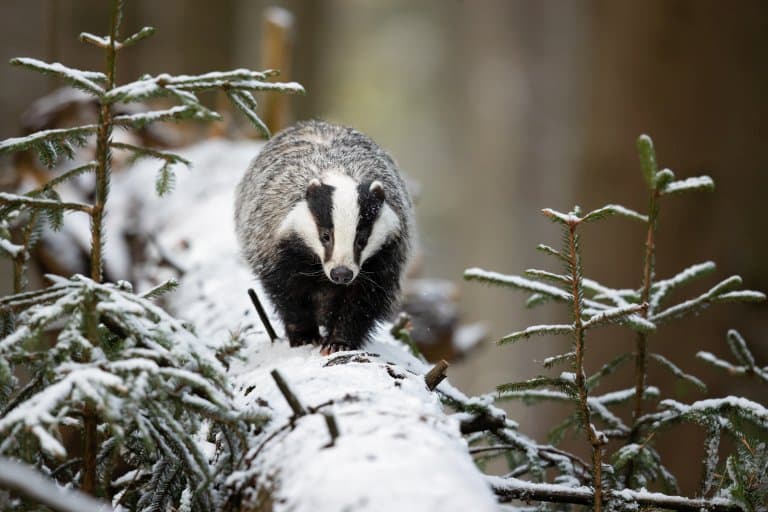
7. Badger hunting
Badgers are widespread and common across Europe and have likely played a role in society since the arrival of humans. Folklore is filled with badger-related tales and characters, and contemporary stories show no sign of breaking this habit.
Their meat is said to taste bad, and this has likely helped protect them from some hunting, but badger pelts have been used to make hats and brushes.
More often, badger hunting was conducted as part of a pest eradication process by farmers tired of having their land dug up, or simply as a pastime for people who like to kill things with guns. 4
8. Badger culls
In recent years, badgers have faced slander from cattle farmers in the UK, who are upset that their introduced food species compete with the ancient wildlife of islands.
Badgers commonly carry a form of tuberculosis, and this is one of their major causes of death. However, it’s reasonably well tolerated in badgers, so they can be long-time carriers before succumbing to it.
A culture of badger hatred has been long fostered among agriculturalists in the UK, as available land for both animals gets smaller with increased demand for meat and dairy products.
Unable to convince the public that the resident dignitaries of the green and pleasant land should be displaced, these industries have begun to push the controversial idea that the badgers are disease-ridden and dangerous.
Glossing over the concept of knowingly eradicating native species to clear space for cattle – something which is rightfully condemned in Brazil – there is a lot of pushback against the idea that badgers are the significant risk they’re made out to be.
One major criticism is the lack of selectiveness of a cull. Badgers are killed indiscriminately, at a rate of up to 30,000 per season, and this suggests a lack of rigour or concern for the species or the individuals involved.
While one assessment shows a 66% decline in bovine TB (bTB) after a cull, but other studies have shown no significant impact. Many other European countries have eradicated bTB without culling all the badgers, so there is talk that perhaps the issue has more to do with the UK’s lax monitoring, overcrowding, and corporate corner-cutting than badgers.
The cultural prejudice against the badger can’t be ignored as a motivator either, though this is not something that’s commonly addressed.
And, sadly, many people don’t need such a justification to harm these gentle animals.
9. Badger baiting
Though highly illegal, blood sports are still rife in many parts of Europe. In the UK alone, cock fights, dog fights, fox hunting and badger baiting still happen, usually in rural areas, and penalties for such barbary have yet to match the crime.
The RSPCA caught five people involved in badger baiting with dogs, trapping the animal in a fake sett and encouraging their dogs to attack it.
The badger was killed, and the dog was seriously injured, too. While people were prosecuted, the fines and short terms involved leave a lot to be desired and draw attention to the limited legal protections offered to animals as a whole.
The deliberate torture of badgers for sport also shares some uncomfortable parallels with the deliberate torture of cows for meat and dairy and highlights our hypocrisy when it comes to which animal we’d rather see come to a terrified end, trapped and violently slaughtered.
But if there’s an argument to be made for one over the other, it’s that badgers play a key constructive role in our ecosystems as fundamental engineers, while cattle contribute to its destruction. 5 6
10. They protect forests
All their digging and pooping helps disperse seeds and creates living spaces for other animals around them.
Badgers have been witnessed living in close quarters with red foxes, but whether this is just less effort than fighting them, or whether either species benefits, remains unclear.
Badgers promote biodiversity in all the regions they occupy, making them a keystone species and more than simply worthy of protection for being cute. As more of the land in Europe is flattened for houses and animal agriculture, the difficult choice between a functioning ecosystem and an elite Western lifestyle becomes more pressing. 7

European Badger Fact-File Summary
Scientific Classification
| Kingdom: | Animalia |
| Phylum: | Chordata |
| Class: | Mammalia |
| Order: | Carnivora |
| Family: | Musetlidae |
| Genus: | Meles |
| Species: | Meles Meles |
Fact Sources & References
- Sabena Jane Blackbird (2013), “European Badger Skull Meles meles Side View”, alamy.
- Josephine Wong (1999), “Vocal Repertoire in the European Badger (Meles meles): Structure, Context, and Function”, Oxford Academic.
- “The fascinating lives of badgers”, Badger Trust.
- Lesley Docksey (2016), “The Eurobadger coalition – fighting for badgers Europe-wide”, Ecologist.
- “IT’S NOT ALL BLACK AND WHITE”, RSPCA.
- Sara H. Downs (Year), “Assessing effects from four years of industry-led badger culling in England on the incidence of bovine tuberculosis in cattle”, Scientific Reports.
- Dr. Przemysław Kurek (2022), “Badger Meles meles as Ecosystem Engineer and Its Legal Status in Europe”, MDPI.
